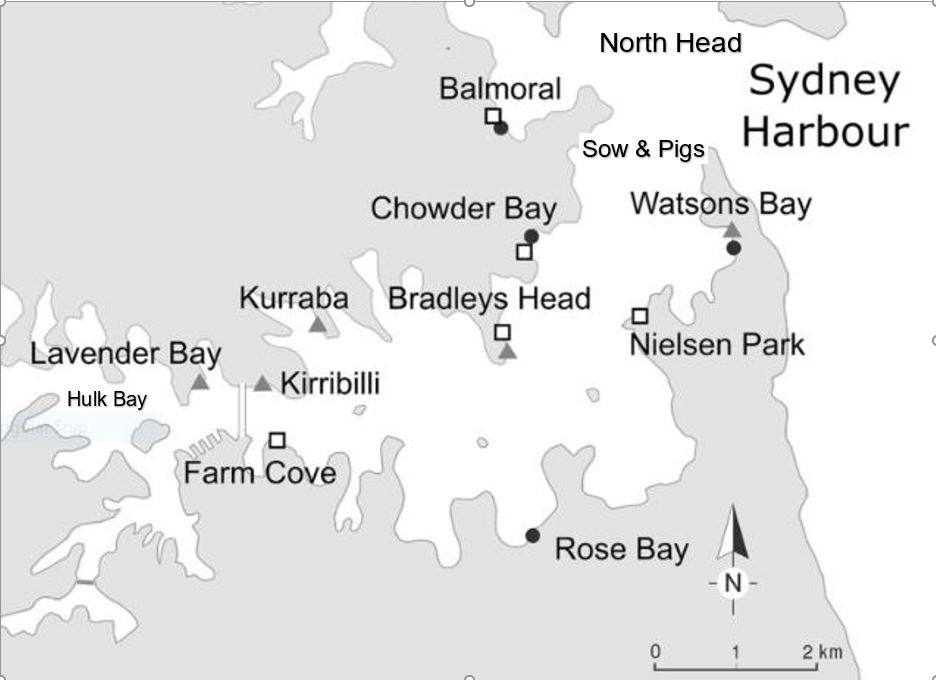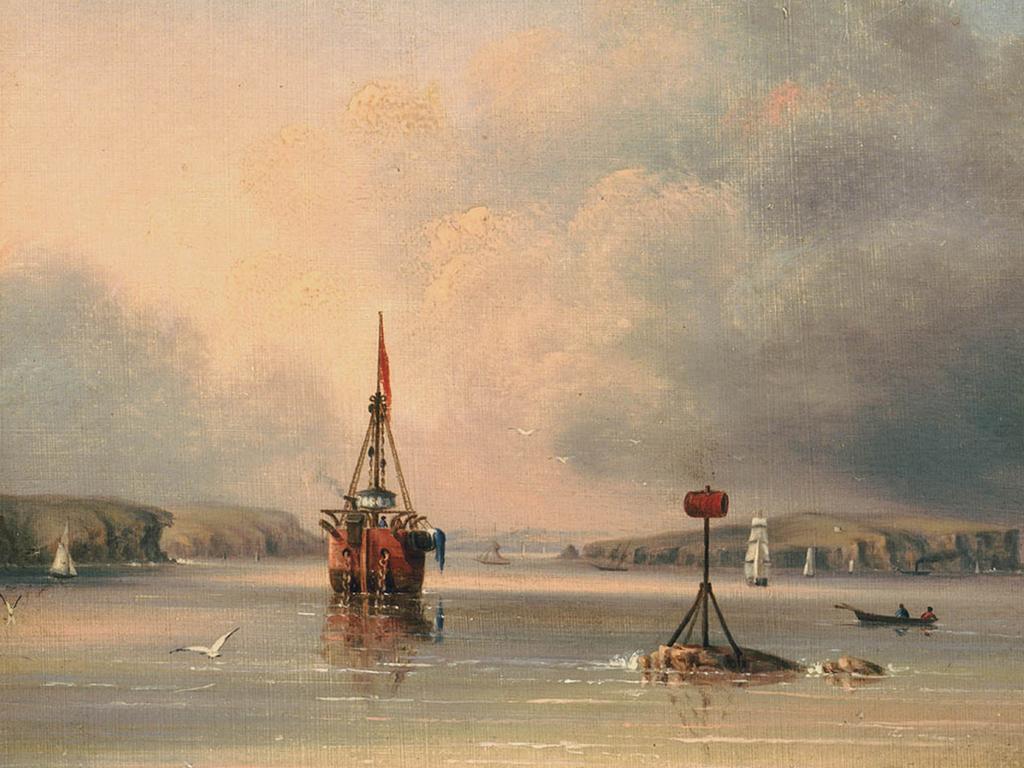- Author
- Editorial Staff
- Subjects
- Ship histories and stories, History - pre-Federation
- Tags
-
- RAN Ships
- None noted.
- Publication
- December 2022 edition of the Naval Historical Review (all rights reserved)
Introduction
The name Hulk Bay does not conjure up romantic notions of a sparkling Sydney Harbour; perhaps this was why it was later renamed Lavender Bay, which remains to this day. But it was the hulk of the ship Phoenix that first gave rise to the name of this harbour-side feature now famous for its Luna Park funfair and expensive housing overlooking the harbour bridge. The ship’s bosun was a well-known character George Lavender and this is the later derivation of Lavender Bay.
The Sailing Ship Phoenix
Of 589-tons burden, Phoenix was a three-deck ship built on the Thames, being launched from the Rotherhithe yard of Randall & Brent on 27 September 1798. Her owners were Hibbert & Company who, owing to continued hostilities with France, had her issued with Letters of Marque and heavily armed with twenty 18-pounder guns. She made a number of successful voyages bringing convicts to New South Wales and Van Diemen’s Land. In the last of these, and the first under the command of Captain Robert White, she is reported to have embarked a contingent from the 40th Regiment1 at Deptford on 3 April 1824. This is more likely to be 3 March, as the ship departed from Portsmouth on 29 March 1824 with 204 male prisoners and arrived in Hobart of 21 July 1824 where she discharged 202 convicts, with a low mortality rate – only two prisoners died on the voyage.

With the 40th contingent still aboard, Phoenix then made for Sydney, first embarking a pilot Mr Gray, and entered the harbour on 5 August during a gale. Unfortunately, she grounded on some dangerous rocky islets known as the Sow and Pigs. With the timely assistance of HMS Tamar and the convict transport Prince Regent, who provided boats to lighten the ship, she was refloated, made her way up harbour and discharged her passengers and cargo on 6 August. She must have been well run as no deaths or injuries are recorded resulting from this tragedy. Following a survey in September, she was found to have broken her back and condemned by the Vice-Admiralty Court to be broken up and her stores sold. Instead she was sold to the colonial government for £1,000, and in May 1825 converted into a prison hulk, and moored opposite Dawes Point in what became known as Hulk Bay.
Captain White and his officers, David Salmon, John Funge and Jeremy Dougherty along with two of the passengers Mr E.H. Thomas and John Evans, published a letter of appreciation to Captain Bremer of the Tamar for his assistance.
In February 1826 Governor Darling visited Phoenix, which had been purchased by his predecessor Governor Brisbane early in 1825. Governor Darling had received a formal but reserved response from the Imperial authorities, expressing the hope that the arrangement for the purchase of the hulk would be temporary2. During her conversion Phoenix had been provided with accommodation for prisoners in 33 cabins which could each hold eight prisoners sleeping in hammocks, so her maximum capacity would be for 264 prisoners plus staff. Officially she was a temporary holding facility for prisoners awaiting transportation to Norfolk Island and Moreton Bay.
Nearby was Goat Island, first used as a quarry in 1831 with high-grade sandstone cut by convicts from Phoenix used in the construction of public buildings. By 1833 the growing quantity of explosives stored in Sydney required a safer location, resulting in a magazine complex being built on the island.
As transport of convicts to and from the hulk to the island wasted time, in 1834 portable wooden buildings were brought to the island which could each house 20 men. A further gang of 80 men was sent from the island for roadmaking between Illawarra and Sydney. In May 1835 conditions for prisoners greatly improved when iron fetters were removed and a schoolmaster employed to help with their appalling rate of illiteracy.

The completion of major building works on Goat Island coincided with the end of Phoenix’s useful life. In late 1837 some convicts still lived on board but the old hulk became unsafe and was towed to Balmain and sold for £145 for scrap; she was broken up in Cockle Bay in 1838.
Harmony was another hulk which in 1853 had been moored off North Head Quarantine Station as a hospital ship She was moved to Hulk Bay from February to November 1863 and used as temporary accommodation to relieve overcrowding at Cockatoo Island. At this time Cockatoo was being used as a prison with the inmates labouring in quarrying and building works.
Sea Bees
The Sydney Morning Herald of 13 August 1863 contains a very interesting letter from Captain John Ross, the first pilot stationed at the south coast port of Moruya.
Sir.
In your paper of the 28th July, I see it stated at a meeting of the Acclimatisation Society of New South Wales that bees were first brought to this country by Dr Braidwood Wilson, from Hobart Town in the year 1831. This is evidently a mistake, bees were broughtfrom England to Sydney in the year 1824 in the ship Phoenix, which sailed from Portsmouth in March of that year, landed prisoners at Hobart Town in June, came to Sydney with a part of the 40th Regiment and Government stores, we stranded on the Sow and Pigs, while entering Port Jackson in July but got off, and brought up to Sydney Cove, condemned and sold to Government, and long afterwards a prison.
The bees were in the charge of Dr Queade3, surgeon-superintendent of that ship, in which I was a junior officer, and it was understood on board that they were sent by the Home Government. However, that may be, I have the most perfect recollection of being on the boat’s crew who conveyed the bees, accompanied by Dr Queade, from Sydney Cove to Parramatta, where they were landed near the Factory, in the presence of Sir Thomas Brisbane4.
After making a voyage to the Islands in a colonial brig named Hawa, I returned to Sydney in February 1826 when I again visited Parramatta. I was then informed that the bees had greatly increased, and were doing well. Soon after I left for India, and did not return to Sydney until 1828, when I found bees common in gentlemen’s grounds, and was given to understand that they were the produce of the bees imported in the ship Phoenix. If you think this of any importance to the public, it is at your service.
While I remain, Sir, truly yours,
John Ross, Pilot Station, Moruya, 10th August.

Summary
The grim features of prison hulks from which many of our forebears came were unfortunate reminders of times past and not expected to reach the sparkling southern continent. But we were penal colonies that seemingly required yet more prisons and, when these were insufficient, prison hulks filled the void. The first of these came by accident when Phoenixstruck a reef. This ship however played another important part in our history in bringing the humble bee to our shores and thereby provided immeasurable support to agriculture and food supplies. When next you cross the Harbour Bridge and Luna Park comes into view spare a thought for those who passed through Hulk Bay.
Notes
1 The 40th (2nd Somerset) Regiment under the command of Lieutenant Colonel William Balfour was despatched to New South Wales in several detachments on a number of ships between 1823 and 1825, thereby also providing guards to the large numbers of prisoners being transported at this time. Those in Phoenix comprised two officers, three sergeants, two drummers and 51 rank and file, who departed from Deptford on 3 April 1824 (sic). The ship first made for Hobart where all 202 convicts disembarked. The 40th Regiment detachment continued to Sydney where they disembarked on 6 August 1824.
2 The first convicts moved into Hyde Park Barracks in May 1819; built to house 600 men, by 1823 it housed over 1000. Darlinghurst Gaol was begun in 1822 but did not take inmates until completion in 1841.
3 Dr Charles Queade was on his fourth voyage as a ship’s surgeon to Australia. He was an unmarried man and surgeon in the Royal Navy on half pay.
4 The first shipment of European honey bees (Apis mellifera) to New South Wales is believed to have arrived on board the convict ship Isabella which arrived at Port Jackson on 9 March 1822. A week later her master Captain John Wallis auctioned seven hives of bees. It seems that this may not have been a success and the colony did not survive, or ‘went bush’, hence the later claim from the Phoenix bees. It is noted that Isabella sailed from Cork on 4 November 1821 with 200 male convicts so the bees may well have originated in Ireland.
References
Clark, Mary Shelley & Clark, Jack, The Islands of Sydney Harbour, Kangaroo Press, Sydney, 2000.
Longhurst, Peta, Materialising Contagion: An Archaeology of Sydney’s North Head Quarantine Station, Thesis for PhD degree, University of Sydney, 2017.
Ross, John, Journal of the Moruya & District Historical Society, June 2013.




